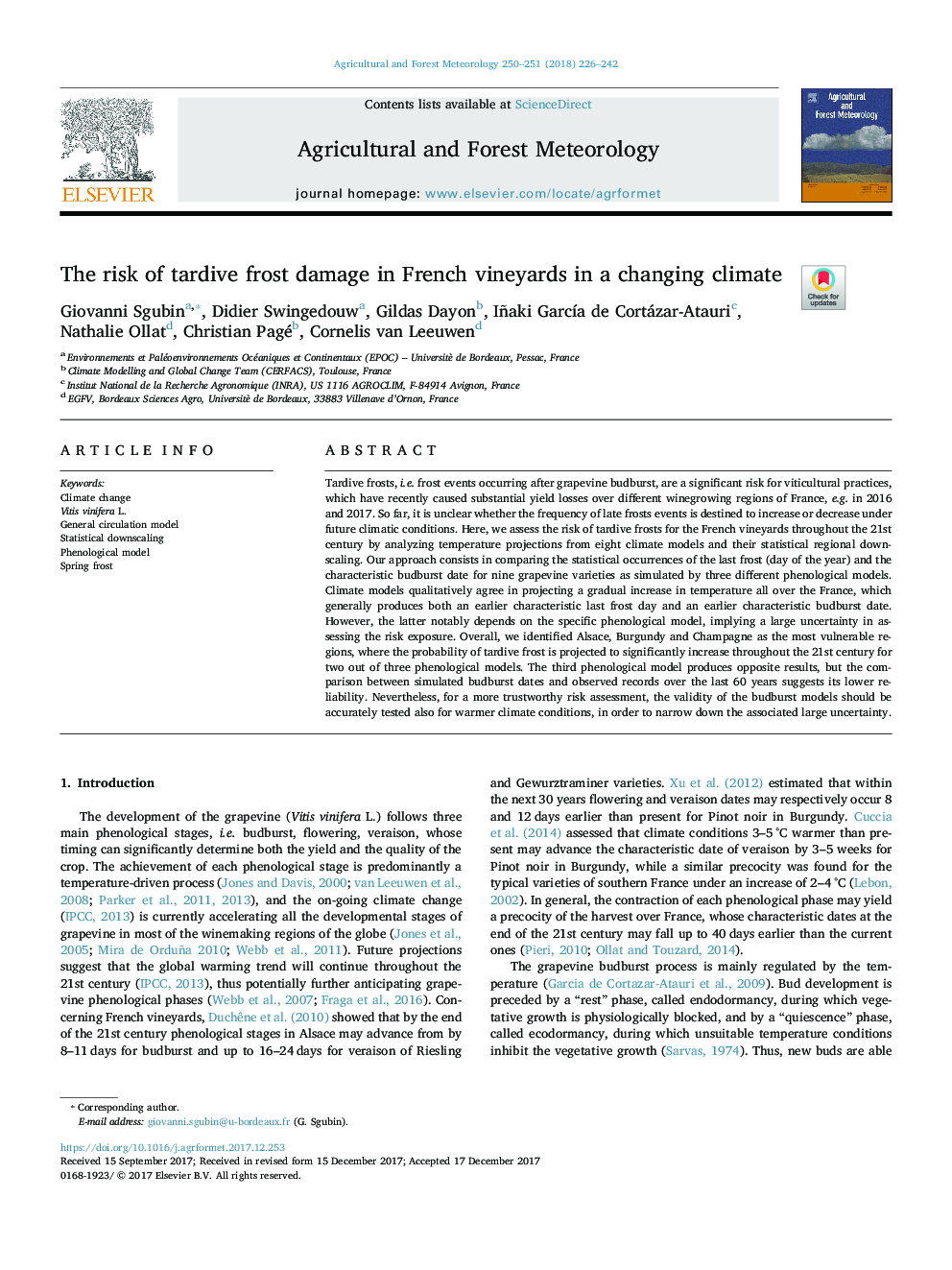| کد مقاله | کد نشریه | سال انتشار | مقاله انگلیسی | نسخه تمام متن |
|---|---|---|---|---|
| 6536813 | 1420851 | 2018 | 17 صفحه PDF | دانلود رایگان |
عنوان انگلیسی مقاله ISI
The risk of tardive frost damage in French vineyards in a changing climate
ترجمه فارسی عنوان
خطر آسیب ناشی از یخبندان در انگورهای فرانسوی در شرایط آب و هوایی متغیر است
دانلود مقاله + سفارش ترجمه
دانلود مقاله ISI انگلیسی
رایگان برای ایرانیان
کلمات کلیدی
ترجمه چکیده
یخ زده ها، به ویژه رویدادهای یخ زده پس از زراعت انگور، خطرات قابل توجهی برای شیوه های کشت زراعی می باشند که اخیرا موجب زیان های قابل توجه تولید در مناطق مختلف فرانسه شده است. در سال 2016 و 2017 تا کنون مشخص نشده است که آیا فرکانس رویدادهای یخبندان دیر به منظور افزایش یا کاهش شرایط زیر آب و هوایی آینده تعیین شده است یا خیر. در اینجا، با توجه به تجزیه و تحلیل پیش بینی های دما از هشت مدل آب و هوایی و کاهش منطقه ای آماری آن، خطر ابتلا به سرماخوردگی های انگور فرانسوی را در طول قرن بیست و یکم ارزیابی می کنیم. رویکرد ما شامل مقایسه رخدادهای آماری گذشته یخبندان (روز سال) و تاریخ مشخصه خرما برای 9 نوع انگور است که به وسیله سه مدل مختلف فنولوژیکی شبیه سازی شده است. مدل های آب و هوا به طور کیفی در طراحی یک افزایش تدریجی دما در سراسر فرانسه توافق می کنند که به طور کلی هر کدام از ویژگی های روز گذشته یخ زده و یک تاریخ مشخصی را نشان می دهد. با این حال، دوم به طور خاص به مدل فنولوژیکی خاص بستگی دارد، که بیانگر عدم اطمینان زیادی در ارزیابی مخاطرات خطر است. به طور کلی، آلزاس، بورگوندی و شامپاین را به عنوان مناطق آسیب پذیر تر شناسایی کردیم، در حالی که احتمال بروز یخ زدگی در طول قرن بیست و یکم برای دو سوم از سه مدل فنولوژیک افزایش چشمگیری داشته است. سومین مدل فنولوژیکی نتایج متفاوتی را تولید می کند، اما مقایسه بین تاریخ های شبح شبیه سازی شده و پرونده های مشاهده شده در 60 سال گذشته نشان می دهد که قابلیت اطمینان پایین تر آن است. با این وجود، برای ارزیابی ریسک قابل اعتماد تر، اعتبار مدل های جوانه زنی باید با دقت برای شرایط گرمتر آب و هوا نیز مورد آزمایش قرار گیرد تا محدودیت عدم اطمینان مربوط به آن را محدود کند.
موضوعات مرتبط
مهندسی و علوم پایه
علوم زمین و سیارات
علم هواشناسی
چکیده انگلیسی
Tardive frosts, i.e. frost events occurring after grapevine budburst, are a significant risk for viticultural practices, which have recently caused substantial yield losses over different winegrowing regions of France, e.g. in 2016 and 2017. So far, it is unclear whether the frequency of late frosts events is destined to increase or decrease under future climatic conditions. Here, we assess the risk of tardive frosts for the French vineyards throughout the 21st century by analyzing temperature projections from eight climate models and their statistical regional downscaling. Our approach consists in comparing the statistical occurrences of the last frost (day of the year) and the characteristic budburst date for nine grapevine varieties as simulated by three different phenological models. Climate models qualitatively agree in projecting a gradual increase in temperature all over the France, which generally produces both an earlier characteristic last frost day and an earlier characteristic budburst date. However, the latter notably depends on the specific phenological model, implying a large uncertainty in assessing the risk exposure. Overall, we identified Alsace, Burgundy and Champagne as the most vulnerable regions, where the probability of tardive frost is projected to significantly increase throughout the 21st century for two out of three phenological models. The third phenological model produces opposite results, but the comparison between simulated budburst dates and observed records over the last 60 years suggests its lower reliability. Nevertheless, for a more trustworthy risk assessment, the validity of the budburst models should be accurately tested also for warmer climate conditions, in order to narrow down the associated large uncertainty.
ناشر
Database: Elsevier - ScienceDirect (ساینس دایرکت)
Journal: Agricultural and Forest Meteorology - Volumes 250â251, 15 March 2018, Pages 226-242
Journal: Agricultural and Forest Meteorology - Volumes 250â251, 15 March 2018, Pages 226-242
نویسندگان
Giovanni Sgubin, Didier Swingedouw, Gildas Dayon, Iñaki GarcÃa de Cortázar-Atauri, Nathalie Ollat, Christian Pagé, Cornelis van Leeuwen,
